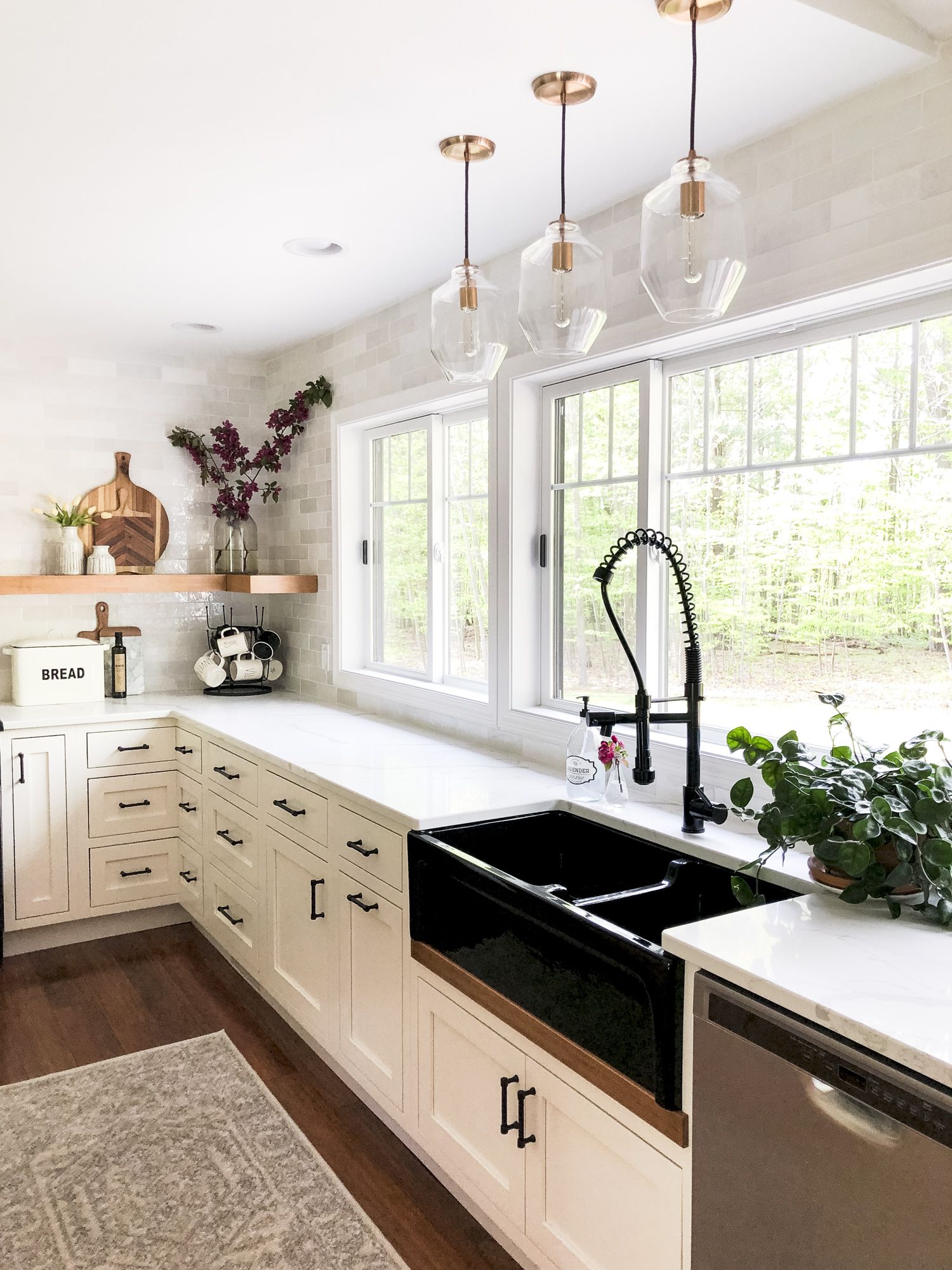EVERYTHING YOU NEED TO KNOW ABOUT FARMHOUSE SINKS
I would say 75% of my clients want a farm sink but with so many brands and materials available it can be really hard to choose the one that is right for you and your family. I am going to break down the facts so you can decide for yourself. I will also share at the end my personal favorites, brands, and answer some common questions I get asked all the time.
Farmhouse Sink Sizes
Your Kitchen designer will be able to tell you what size sink you need depending on the sink base they designed into your space. When my clients tell me they want a farm sink I try to design in a 39″ sink base if the space allows so I can give them an oversized farm sink 36″ wide farm sink. So, whatever your overall farm sink base is (if you subtract -3″ from it) that will be the sink size you need to order.
The most popular size I see designed in is a 36″ Sink base, and a 33″ overall wide farm sink.
Farmhouse Sink Materials
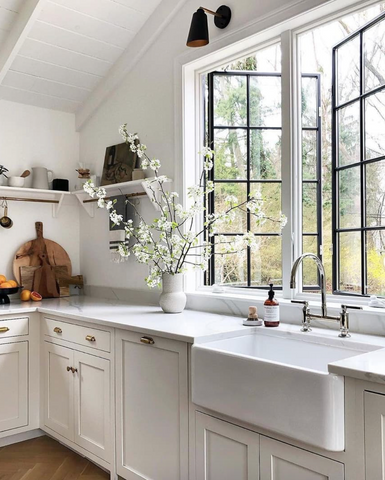
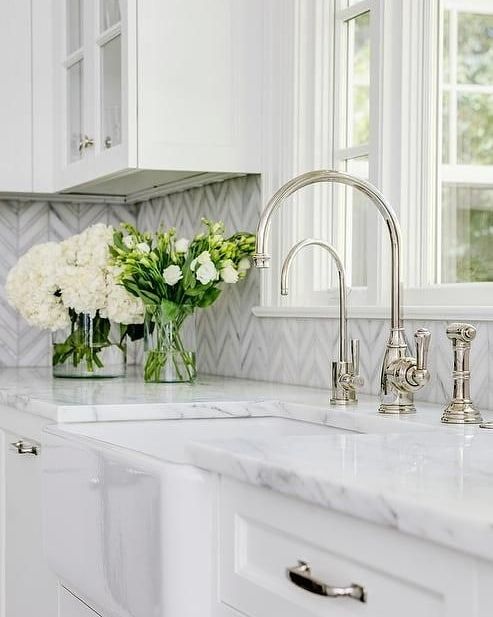
There’s a lot of personal preference involved when choosing the best kitchen sink material. I will go through and breakdown the ins and outs of these options below. I do have to say my favorite material personally is the Fireclay.
- Fireclay – Easy to clean and maintain, durable with a classic look
- Stainless Steel – Cheapest option perfect for the budget shopper
- Cast Iron – Heavy duty with exact measurements for “easier” installation
- Granite Composite – More cost-effective compared to natural Stone
- Copper – Bold, unique finish that is anti-bacterial
- Stone – Earthy but polished look offers high style
- Porcelain – Wide variety of color options
#1 FIRECLAY

If you’re looking for a traditional but timeless focal point for your kitchen, a fireclay farmhouse sink is a stunning choice. Fireclay sinks are crafted from ceramic clay. That’s dried at high heat and then fired in a kiln at an even higher temperature to fuse on a porcelain enamel outer layer. This process increases the durability of both the ceramic clay and porcelain enamel while giving the sink a glossy shine.
This finish makes the fireclay farmhouse sink resistant to chips, scratches, fading, discoloration, and stains. Fireclay sinks are one of the easiest types of kitchen sinks to maintain, offering easy cleanup with nothing more than a sponge or cloth, although you can use more abrasive cleaners as needed. Another benefit of fireclay sinks is they have a consistent look through both layers. A chip will not be that noticeable as the clay layer looks the same. In addition, fireclay apron front sinks are entirely rust-proof.
Because the enamel is applied separately, you can find fireclay farmhouse sink in a wide array of colors such as white, black or blue, or models with a unique swirl or grid patterns on the front apron. In addition, fireclay sinks are available in both single and double bowl models.
While fireclay farmhouse sinks tend to be more expensive than other materials, brands like Crestwood offer cheap fireclay farmhouse sinks that may be more affordable for your budget. Keep in mind that fireclay farmhouse sink is generally quite heavy and may require additional support from surrounding cabinetry, so you’ll want to know early in on your kitchen design process if you’re planning to install one. Additional brands I highly recommend are Rohl and Nantucket Kitchen sinks.
Benefits Of Fireclay
- The classic glossy finish blends seamlessly with traditional kitchen designs
- 100% rust-proof
- Lowest maintenance available; resistant to chips, scratches, fading, discoloration, and dents
- Extremely Durable
- Available in multiple colors
- Available in Single or Double (Split) Bowl
Considerations
- Very heavy kitchen sink
- More expensive than other materials
- Hard to install
- Dishware can break is dropped in the hard surface
- Professional installation is recommend.
#2 Stainless Steel
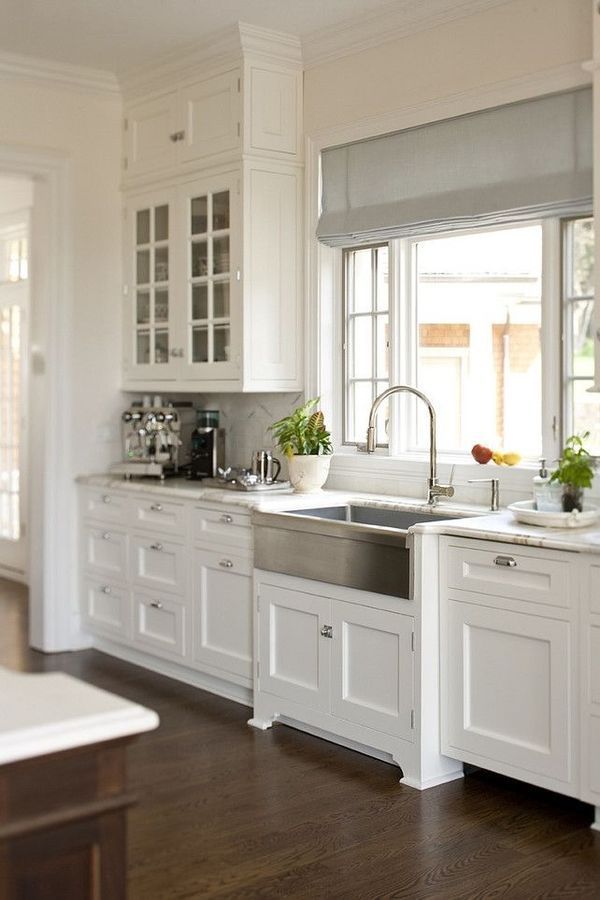
As the most popular material for kitchen sinks, stainless steel sinks offer one major benefit to consumers: affordability. The price of your stainless steel sink will likely depend on the gauge or weight of the steel. The lower the gauge, the thicker the steel. Most steel farmhouse sinks have a gauge between 18 to 22 inches, but you can find them all the way from 15 to 24 inches. A heavier gauge may reduce sound and minimize dents, scratches, and other wear and tear.
Of course, a more affordable sink comes with some trade-offs. Stainless steel sinks are noisier than other materials, although you can find versions with sound-absorbing rubber pads built-in. It can be noisy when dealing with pots and pans. They also tend to show water spots more easily and it may take a bit more effort to keep them looking immaculate. Stainless steel sinks are also more prone to scratches and dents, but on the plus side, they’re very resistant to high heat and stains. A brushed or satin finish stainless steel sink can help disguise wear more than a mirrored or chrome-like finish. Relatively, they are low maintenance.
From an aesthetic point of view, a stainless steel sink coordinates easily with stainless steel appliances. Stainless steel is by far the most popular finish out there for fridges, ranges, and other appliances, as well as kitchen hardware and faucets. However, if you’re making an effort to choose fixtures that offer a different finish or blend into your cabinetry, a stainless steel sink may stick out in your overall kitchen design.
Another benefit of stainless steel is the versatility of the sink layout. You can buy stainless steel apron front sinks in both single and double bowl varieties. In addition, many double bowl farmhouse sinks have different layouts to emphasize one basin over the other.
Benefits Of Stainless Steel
- Affordability
- Easy to match to appliances
- Heat and stain resistant
- Easier to sterilize
- Forgiving with fine china and glassware
Considerations
- Tends to be noisier
- Prone to showing scratches and water spots
- May not coordinate with the rustic look
#3 Cast Iron
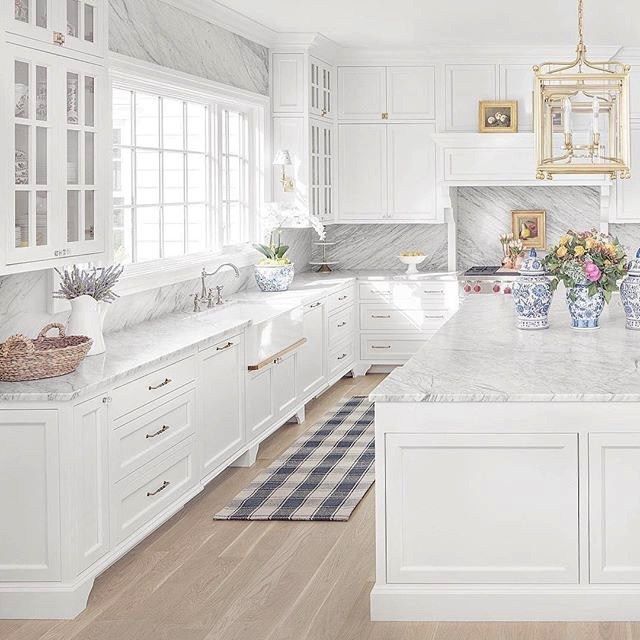
Cast iron seems like a natural fit for any rustic kitchen design, as it’s one of the oldest traditional materials still used today. A common debate is cast iron vs. fireclay since they have similar qualities. Cast iron farmhouse sinks offer a pristine glossy enamel finish, which is made by melting glass that is fused on through the process of casting iron, to prevent rusting. While that finish may look sleek and smooth, it’s also incredibly durable and resistant to scratches. You’ll have an easy time keeping your cast iron sink clean, as the material resists stains and water spots too.
The durability cast iron sinks are famous for equals a heavier weight, which can impact the design of your kitchen. If you’re going the cast iron apron sink route, you’ll need to plan for additional support via the surrounding cabinetry. It will also more than likely require a professional to install, as the hefty weight will be a challenge for DIYers to manage themselves. Although cast iron sinks are supremely sturdy, if they do chip and the bare iron is exposed, it can rust quickly.
As you may expect with a more durable material like cast iron, your farmhouse kitchen sink will likely cost more than other materials. This is particularly true if you want something other than a white cast iron farmhouse kitchen sink. While different colors and finishes exist, they may cost a premium.
Benefits Of Cast Iron
- A highly durable scratch-resistant material can last for decades
- Easy to maintain and keep clean
- Classic glossy white finish
- Exact measurements
Considerations
- Expensive compared to more affordable materials like stainless steel
- Colors other than white carry a notable additional cost
- Risk of stains, chips and rusting
- Can actually break your dishes if dropped into the sink
#4 Granite Composite

Granite composite farmhouse sinks are a mixture of either crushed quartz or granite with an acrylic resin filler. Typically these sinks are made from 80% stone and 20% resin. Why not just get a granite farmhouse sink? On its own, granite and quartz require a lot of maintenance, plus they’re incredibly pricey. Mixed with resin, however, composite farmhouse sinks are far more durable and easier to take care of, plus much more affordable. Granite composite farmhouse sinks are among the toughest out there, resistant to scratches and stains. While quartz composite farmhouse sinks are available, they are not considered quite as durable.
Care needs to be taken, particularly during delivery and install, to ensure your granite composite farmhouse sink doesn’t crack. Granite composite is, however, a very sturdy material that can resist heat and fading. Plus, granite composite sinks don’t require the use of harsh chemicals to get them clean – a nylon brush is all you need to keep your composite farmhouse sink looking sparkling.
Because the source material for composite sinks is so varied, so too are the range of options when it comes to colors and finishes. In fact, the most common colors of granite composite sinks are brown, taupe, and black. Composite granite and quartz front apron sinks are also relatively affordable. They may cost more than a stainless-steel sink, but they are generally priced well below more expensive options like cast iron and fireclay.
Benefits Of Cast Iron
- Highly durable, resistant to scratches and stains
- A wide range of color choices
- Affordability
- Do not require chemicals for cleaning
Considerations
- Only available in matte finishes
- Can be prone to cracking without proper care
#5 Copper
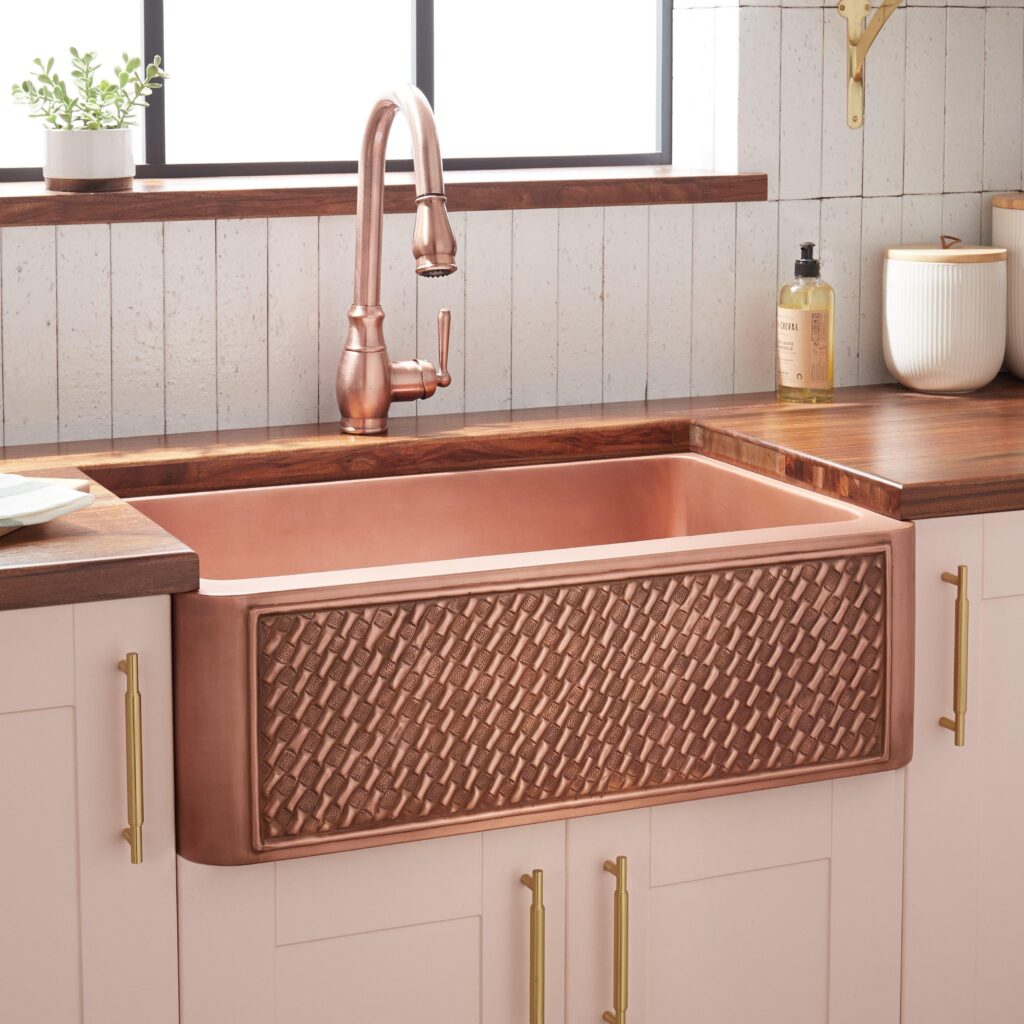
Copper is making a comeback in kitchen design, whether it’s through cabinetry hardware, faucets, and taps, or even a copper farmhouse sink. If you want to make a striking design statement, a copper farmhouse sink will give your space a truly rustic touch. Copper is naturally stain-resistant, rust-resistant and anti-microbial, killing bacteria to ensure your sink remains sanitary with next to no effort.
You can actually find functioning antique copper apron sinks that are 50-100 years old. That’s because copper farmhouse sinks are engineered to last, although they do come with a bigger price tag to match. To ensure your copper apron sink has a long life, look for models that are at least 99% pure copper; a small amount of zinc may be added to increase the sink’s strength. A lower gauge (thicker) copper will also ensure the life and durability of your copper apron sink.
You’ll want to be careful with how you clean your copper apron front sink. A mild soap and water or a specialty copper cleaner is all you need. You’ll also want to ensure your sink doesn’t come into contact with hot pots and pans, as well as acidic food and drinks such as orange juice. Even with great care, keep in mind that copper will more than likely develop a patina and darken over time.
Copper sinks come in varying degrees of matte or shiny finishes, as well as both single and double bowl models. Look for ornate flourishes, such as a sculptural or basket weave design on the front apron to increase the visual impact of your copper farmhouse sink.
Benefits Of Copper
- Attractive and unique finish suits traditional kitchen designs
- Naturally antimicrobial material kills almost 100% of harmful bacteria
- Durable and long-lasting
- Recyclable
- Most are hand made
- One of the longest-lasting materials known to man
Considerations
- Requires care in terms of exposure to heat, acidic foods and drinks, and harsh chemical cleaners
- More expensive than other materials
- Can discolor over time
- Is a softer material (be careful with sharp objects)
#6 Stone
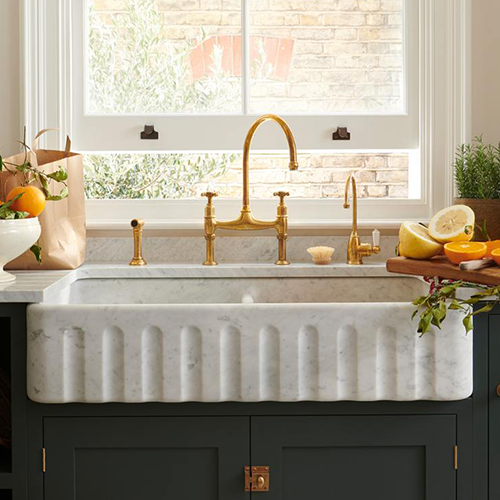
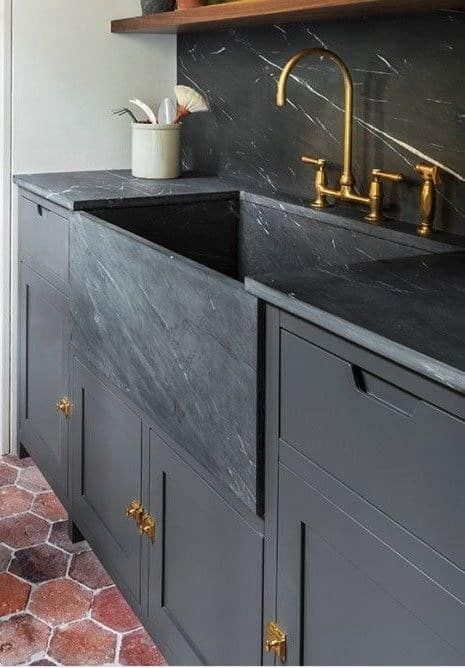
Natural stone gives an earthy yet polished look for your kitchen and can be used for both countertops and sinks. Stone farmhouse sinks are either made from a single solid slab of stone that’s been carved into a sink bowl or is made from stone slabs that have been combined and then formed into a sink. The natural qualities of stone sinks actually make them quieter than other materials.
Some stone farmhouse sinks can be prone to stains, so you may want to get a sample of your stone and test it out. Different stone materials will perform differently – soapstone, for example, is a softer stone that is more stain resistant, but also more fragile. To preserve the life and look of your stone apron sink, you may need to reseal it every year or two.
Stone farmhouse sinks are among the most expensive out there, but they offer high style. Natural stone provides a distinct look for your sink, with unique marbling and patterns. You can find natural stone apron sinks in colors ranging from bright white to neutral grey to jet black. Plus, some natural stone sinks have stylish curved or embellished fronts. For an extra unique design, keep an eye out for stone sinks made of petrified wood – fossilized wood that has now turned to stone.
Benefits Of Stone
- Potential to match to countertops for a seamless look
- Distinctive, one of a kind look thanks to properties of natural stone
- Rust-proof
- Dent, stain, and heat-resistant when sealed properly
Considerations
- More expensive than other materials
- Potentially prone to stains
- Different types of stone may be more fragile
- May require re-sealing every couple of years
#7 Porcelain
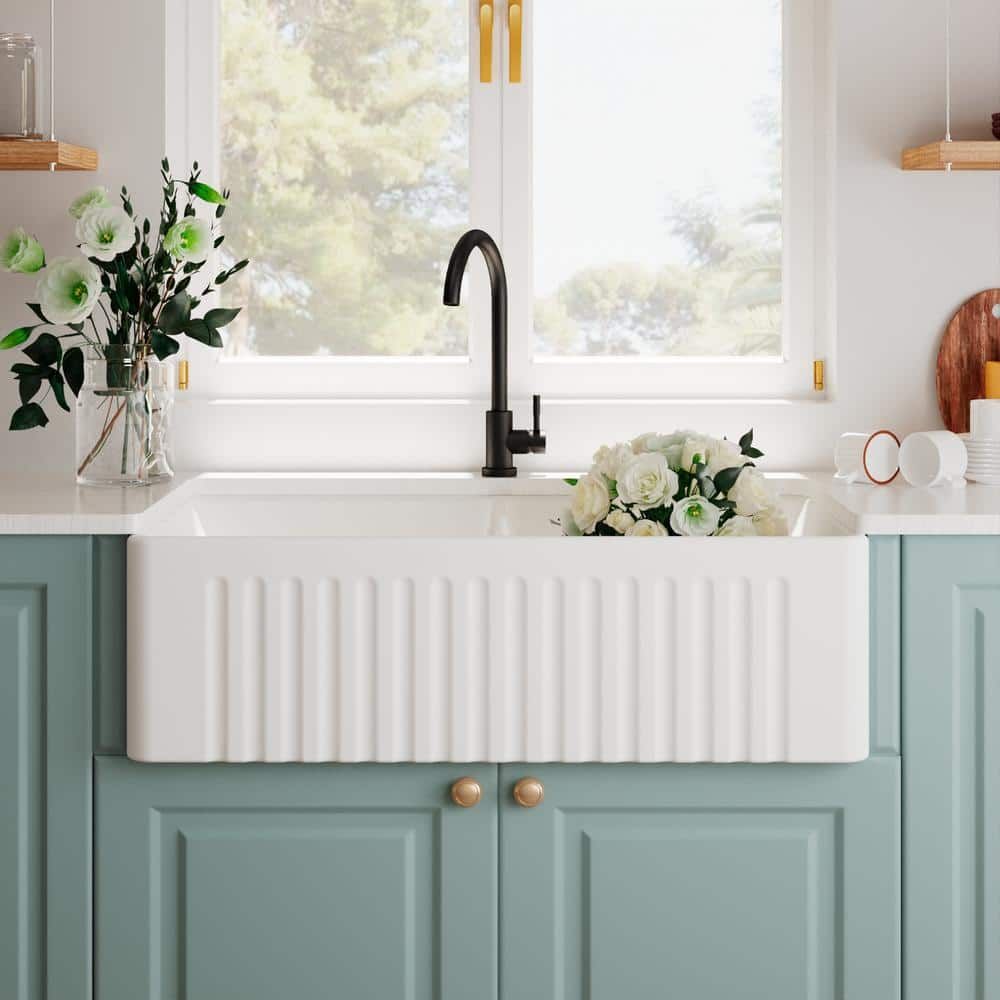
Porcelain, ceramic, or vitreous china sinks are one of the more traditional materials available for your farmhouse sink. Because of the longstanding popularity of porcelain as a sink material, ceramic farmhouse sinks tend to be very affordable and come in a vast array of styles and shapes, including virtually any color you can imagine.
Typically speaking, porcelain sinks are more found in bathrooms because they are more fragile than other sink materials. These are great bathroom sinks. Dropping a heavy pot or sharp object on your porcelain apron sink can cause damage, although there are kits available that can repair some chips or cracks. On the plus side, porcelain is a very heat-resistant material. You’ll also want to avoid cleaning your porcelain farmhouse sink with abrasive or harsh cleaners as they can dull the surface and lead to build-up over time.
For additional durability, porcelain farmhouse sinks are often available as either porcelain enamel overcast iron or porcelain enamel over steel. Porcelain cast iron sinks are sturdier than porcelain steel varieties of sink materials. In terms of appearance, look for porcelain farmhouse sinks with classic details like a built-in drainboard or fluted front.
Benefits Of Porcelain
- Affordability
- A wide variety of finishes and colors
- Warm, traditional look suits farmhouse style kitchens
Considerations
- Not very durable for heavier kitchen usage
- Prone to chips
Farmhouse Sink Brands
Choosing the best brand can be as challenging as choosing the sink materials. There are a lot of fake, cheap or knock-offs that are circulating online. As always research is the key. Choosing a brand with a proven track record and consistent reviews will help.
Lucky when you shop with me, I’ve already done all the research for you.
My Recommendations in Order:
- Rohl – The Shaw’s Original Sink has been used since the 1800s.
- Bocchi – Best value fireclay sinks with 9 color options.
- Nantucket – New England inspired for a classic cottage feel.
- Crestwood – (New kid on the block) Provides affordable fireclay sinks with brand new color options.
Conclusion
Ultimately the ideal farmhouse sink material depends largely on your budget and the look you’re going for. Fireclay farmhouse sinks offer the classic country look and next to no maintenance, with a price tag that’s lower than cast iron or copper. If you’re on the hunt for a unique finish, natural stone, composite granite, or copper farmhouse sinks may be the best choice.
If budget’s your top priority, there are plenty of affordable and stylish porcelain and stainless steel farmhouse sinks available. No matter what, an apron sink is sure to be a standout element of your overall kitchen design.
No matter which farmhouse sink materials you look into, you will find one perfect for your style, budget and use.
FAQ’s
What is the difference between a farm sink and an apron sink?
Nothing significant most of the time the terms are used interchangeably.
How to install a farm sink?
Refer to specific manufacturer’s instructions.
Are farmhouse sinks top mount or undermount?
They come in both top mount and undermount options. I recommend under-mount.
Are Farmhouse sinks a fad?
Absolutely not! Farmhouse sinks are timeless and traditional. They’ve been used since there was no running water (over 100 years) and are still popular in homes today. Farmhouse sinks is a fantastic centerpiece of kitchens of many kitchen design styles – not only Farmhouse Kitchens!
What’s so great about a farmhouse sink?
Not only are farmhouse sinks stylish they are practical too. The extra-deep bowl is great for cleaning and standing so close to the sink avoids back pain. Also, they are proven to increase your home’s value.
How far should a farmhouse sink stick out?
I recommend 1.5- 2 inches depending on cabinet construction and door style thickness.
What size cabinet do you need for an apron sink?
If it’s undermount we recommend a cabinet that is 3 inches wider. That way you have 1.5 inches on either side.
How much is a farmhouse sink?
Average price range is between $500-$650 but can be found as low as $349 and go all the way up to $3,000+
How deep is a farmhouse sink?
The average depth is between 9-10 inches.
